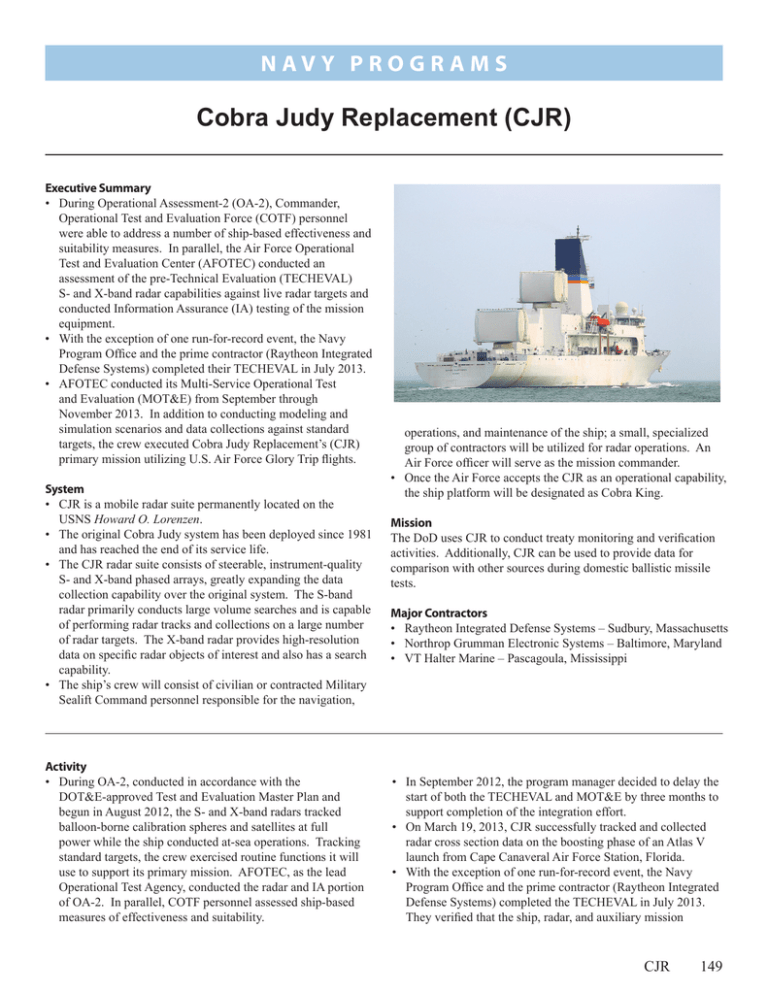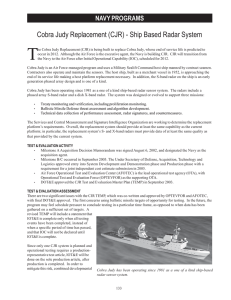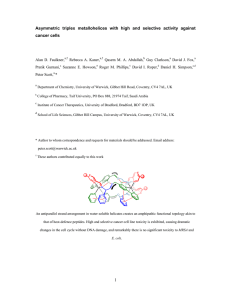Cobra Judy Replacement (CJR)
advertisement

N av y P R O G R A M S Cobra Judy Replacement (CJR) Executive Summary • During Operational Assessment-2 (OA-2), Commander, Operational Test and Evaluation Force (COTF) personnel were able to address a number of ship-based effectiveness and suitability measures. In parallel, the Air Force Operational Test and Evaluation Center (AFOTEC) conducted an assessment of the pre-Technical Evaluation (TECHEVAL) S- and X-band radar capabilities against live radar targets and conducted Information Assurance (IA) testing of the mission equipment. • With the exception of one run-for-record event, the Navy Program Office and the prime contractor (Raytheon Integrated Defense Systems) completed their TECHEVAL in July 2013. • AFOTEC conducted its Multi-Service Operational Test and Evaluation (MOT&E) from September through November 2013. In addition to conducting modeling and simulation scenarios and data collections against standard targets, the crew executed Cobra Judy Replacement’s (CJR) primary mission utilizing U.S. Air Force Glory Trip flights. System • CJR is a mobile radar suite permanently located on the USNS Howard O. Lorenzen. • The original Cobra Judy system has been deployed since 1981 and has reached the end of its service life. • The CJR radar suite consists of steerable, instrument-quality S- and X-band phased arrays, greatly expanding the data collection capability over the original system. The S-band radar primarily conducts large volume searches and is capable of performing radar tracks and collections on a large number of radar targets. The X-band radar provides high-resolution data on specific radar objects of interest and also has a search capability. • The ship’s crew will consist of civilian or contracted Military Sealift Command personnel responsible for the navigation, Activity • During OA-2, conducted in accordance with the DOT&E‑approved Test and Evaluation Master Plan and begun in August 2012, the S- and X-band radars tracked balloon‑borne calibration spheres and satellites at full power while the ship conducted at-sea operations. Tracking standard targets, the crew exercised routine functions it will use to support its primary mission. AFOTEC, as the lead Operational Test Agency, conducted the radar and IA portion of OA-2. In parallel, COTF personnel assessed ship-based measures of effectiveness and suitability. operations, and maintenance of the ship; a small, specialized group of contractors will be utilized for radar operations. An Air Force officer will serve as the mission commander. • Once the Air Force accepts the CJR as an operational capability, the ship platform will be designated as Cobra King. Mission The DoD uses CJR to conduct treaty monitoring and verification activities. Additionally, CJR can be used to provide data for comparison with other sources during domestic ballistic missile tests. Major Contractors • Raytheon Integrated Defense Systems – Sudbury, Massachusetts • Northrop Grumman Electronic Systems – Baltimore, Maryland • VT Halter Marine – Pascagoula, Mississippi • In September 2012, the program manager decided to delay the start of both the TECHEVAL and MOT&E by three months to support completion of the integration effort. • On March 19, 2013, CJR successfully tracked and collected radar cross section data on the boosting phase of an Atlas V launch from Cape Canaveral Air Force Station, Florida. • With the exception of one run-for-record event, the Navy Program Office and the prime contractor (Raytheon Integrated Defense Systems) completed the TECHEVAL in July 2013. They verified that the ship, radar, and auxiliary mission CJR 149 N av y P R O G R A M S equipment met the defined performance specifications and declared the system ready for MOT&E execution. • AFOTEC conducted its MOT&E from September through November 2013 in accordance with the DOT&E-approved test plan. In addition to conducting modeling and simulation scenarios and data collection against standard targets such as satellites and balloon-borne spheres, the crew executed CJR’s primary mission using Air Force Glory Trip flights. Assessment • The CJR program executed a compressed test schedule caused by programmatic complications and technical setbacks during the integration and developmental test phase DT-VI, which resulted in three-month delays of TECHEVAL and MOT&E. The Program Office balanced the need for adequate testing with the pressure to retire an aging and difficult-to-maintain legacy Cobra Judy system without any gaps in mission capability or technical performance. • During OA-2, COTF personnel were able to address many of the ship-based performance measures (i.e., ship speed, endurance, replenishment, habitability, etc.). However, during this event, none of the radar effectiveness measures were resolved, although the crew did collect metric and signature data against test balloons and satellites, mainly using S-band and a partial X-band array. At the time, the radar arrays were 150 CJR • • • • not fully calibrated and a failure of a replaceable unit in the X-band radar led to only a partial test of the radar’s capability. Following TECHEVAL, a number of Category II software deficiencies were noted and addressed. The fixes will be implemented following completion of the MOT&E. Modeling and simulation was an essential part of the test strategy as it is impossible to observe the wide range of ballistic missile phenomenology relying solely on targets of opportunity. Operational testing involved demonstrating not only the ship and radar performance during the conduct of a mission, but also the pre-mission planning and transmission of collection data and post-mission data analysis using software tools developed and largely tested under a separate acquisition program. The Atlas V launch provided valuable data, revealing system deficiencies that were corrected through system modifications to improve operator situational awareness and system operational procedures. An assessment of MOT&E test mission data with respect to the effectiveness and suitability of the CJR is ongoing. Recommendations • Status of Previous Recommendations. This is the first annual report for this program. • FY13 Recommendations. None.








